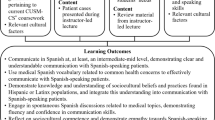Abstract
Background
There is no standardized curriculum or assessment method that addresses Spanish skills in U.S. medical schools. The authors implemented a 10-week Clinical Medical Spanish elective for fourth-year medical students.
Methods
Data were collected for 58 students from 2013 to 2015 pertaining to pre- and post-course self-evaluation of Medical Spanish comfort level and Objective Structured Clinical Examinations.
Results
Student comfort level with Spanish-speaking patients improved for performing history and examination skills (P < 0.05). Standardized Patient (SP) and faculty-rated fluency were each higher than the student self-rated pre-course fluency (P < 0.001). Fluency levels were higher than the faculty rating of student ability to perform the medical interview (P < .001).
Discussion
Differences in student self-rating, SP scores, and faculty assessment illustrate the complexities of assessing medical skills in a second language, and highlight the importance of training and evaluating medical students and hospital staff in the appropriate use of Medical Spanish.

Similar content being viewed by others
References
Hardin KJ, Hardin DM. Medical Spanish programs in the United States: a critical review of published studies and a proposal of best practices. Teach Learn Med. 2013;25(4):306–11.
Zong J, Batalova J. The limited English proficient population in the United States. Migration Policy Institute, 2015. http://www.migrationpolicy.org/article/limited-english-proficient-population-united-states. Accessed January 13, 2016.
Huang J, Jones K, Regenstein M, Ramos C. Talking with patients: how hospitals use bilingual clinicians and staff to care for patients with language needs (Issue brief: Survey findings). Washington, DC: Department of Health Policy, School of Public Health and Health Services, The George Washington University, 2009.
Colby SL, Ortman JM. Projections of the size and composition of the U.S. Population: 2014 to 2060, Current Population Reports, P25-1143, U.S. Census Bureau, Washington, DC, 2014.
Ortman JM, Shin HB. Language projections 2010–2020, U.S. Census Bureau, 2011. http://www.census.gov/hhes/socdemo/language/data/acs/Ortman_Shin_ASA2011_paper.pdf. Accessed January 13, 2016.
Morales R, Rodriguez L, Singh A, Stratta E, Mendoza L, Valerio MA, Vela M. National Survey of medical Spanish curriculum in U.S. medical schools. J Gen Intern Med. 2015;30(10):1434–9.
Divi C, Koss RG, Schmaltz SP, Loeb JM. Language proficiency and adverse events in US hospitals: a pilot study. Int J Qual Health Care. 2007;19(2):60–7.
Fernandez A, Schillinger D, Grumbach K, Rosenthal A, Stewart AL, Wang F, Pérez-Stable EJ. Physician language ability and cultural competence. An exploratory study of communication with Spanish-speaking patients. J Gen Intern Med. 2004;19(2):167–74.
Bean MG, Focella ES, Covarrubias R, Stone J, Moskowitz GB, Badger TA. Documenting nursing and medical students’ stereotypes about Hispanic and American Indian patients. J Health Dispar Res Pract. 2014;7(4):14.
Tucker JD, Chen AH, Glass RI. Foreign language assessment and training in U.S. medical education is a must. Acad Med. 2012;87(3):257.
Vela MB, Fritz C, Girotti, J. Medical students’ experiences and perspectives on interpreting for LEP patients at two US medical schools. J Racial Ethn Health Disparities. 2015 May 1–5.
Landau RE, Beck A, Glickman LT, Litster A, Widmar NJ, Moore GE. Survey of US veterinary students on communicating with limited English proficient Spanish-speaking pet owners. J Vet Med Educ. 2015;42(4):324–31.
Rodriguez F, Cohen A, Betancourt JR, Green AR. Evaluation of medical student self-rated preparedness to care for limited English proficiency patients. BMC Med Educ. 2011;11:26.
Lion KC, Thompson DA, Cowden JD, Michel E, Rafton SA, Hamdy RF, Killough EF, Fernandez J, Ebel BE. Clinical Spanish use and language proficiency testing among pediatric residents. Acad Med. 2013;88(10):1478–84.
Lion KC, Thompson DA, Cowden JD, Michel E, Rafton SA, Hamdy RF, Killough EF, Fernandez J, Ebel BE. Impact of language proficiency testing on provider use of Spanish for clinical care. Pediatrics. 2012;130(1):e80–7.
Rosenthal A, Wang F, Schillinger D, Pérez Stable EJ, Fernandez A. Accuracy of physician self-report of Spanish language proficiency. J Immigr Minor Health. 2011;13(2):239–43.
Ortega P. Spanish and the medical interview: a textbook for clinically relevant medical Spanish. 2nd ed. Philadelphia, PA: Elsevier; 2015.
Chalabian J, Dunnington G. Standardized patients: a new method to assess the clinical skills of physicians. Best Pract Benchmarking Healthc. 1997;2(4):174–7.
Karkowsky CE, Chazotte C. Simulation: improving communication with patients. Semin Perinatol. 2013;37(3):157–60.
O'Rourke KM, Gruener G. A standard for medical Spanish credentialing. Acad Med. 2014;89(4):531–2.
Schoonheim-Klein M, Hoogstraten J, Habets L, Aartman I, Van der Vleuten C, Manogue M, Van der Velden U. Language background and OSCE performance: a study of potential bias. Eur J Dent Educ. 2007;11(4):222–9.
Costa A, Sebastián-Gallés N. How does the bilingual experience sculpt the brain? Nat Rev Neurosci. 2014;15(5):336–45.
Andres E, Wynia M, Regenstein M, Maul L. Should I call an interpreter? How do physicians with second language skills decide? J Health Care Poor Underserved. 2013;24(2):525–39.
Author information
Authors and Affiliations
Corresponding author
Ethics declarations
Funding
This study was funded in part by the Centers of Excellence Program, Health Resources and Services Administration, U.S. Department of Health and Human Services, grant no. D34HP24461.
Ethical Approval
This study was approved by the institutional review board of the University of Illinois at Chicago. Approval date: June 9, 2015, Protocol no. 2012-0783. All procedures performed in the study were in accordance with the ethical standards of the institutional and/or national research committee and with the 1964 Helsinki declaration and its later amendments or comparable ethical standards.
Conflicts of Interest
The authors declare that they have no conflicts of interest.
Rights and permissions
About this article
Cite this article
Ortega, P., Park, Y.S. & Girotti, J.A. Evaluation of a Medical Spanish Elective for Senior Medical Students: Improving Outcomes through OSCE Assessments. Med.Sci.Educ. 27, 329–337 (2017). https://doi.org/10.1007/s40670-017-0405-5
Published:
Issue Date:
DOI: https://doi.org/10.1007/s40670-017-0405-5




